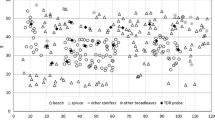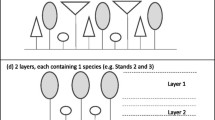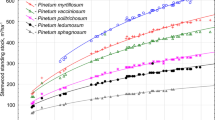Abstract
In the face of climate change and accompanying risks, forest management in Europe is becoming increasingly important. Model simulations can help to understand the reactions and feedbacks of a changing environment on tree growth. In order to simulate forest growth based on future climate change scenarios, we tested the basic processes underlying the growth model BALANCE, simulating stand climate (air temperature, photosynthetically active radiation (PAR) and precipitation), tree phenology, and photosynthesis. A mixed stand of 53- to 60-year-old Norway spruce (Picea abies) and European beech (Fagus sylvatica) in Southern Germany was used as a reference. The results show that BALANCE is able to realistically simulate air temperature gradients in a forest stand using air temperature measurements above the canopy and PAR regimes at different heights for single trees inside the canopy. Interception as a central variable for water balance of a forest stand was also estimated. Tree phenology, i.e. bud burst and leaf coloring, could be reproduced convincingly. Simulated photosynthesis rates were in accordance with measured values for beech both in the sun and the shade crown. For spruce, however, some discrepancies in the rates were obvious, probably due to changed environmental conditions after bud break. Overall, BALANCE has shown to respond to scenario simulations of a changing environment (e.g., climate change, change of forest stand structure).







Similar content being viewed by others
References
Balster NJ, Marshall JD (2000) Decreased needle longevity of fertilized Douglas-fir and grand fir in the northern Rockies. Tree Physiol 20:1191–1197
BayFORKLIM (1996) Klimaatlas Bayern. Fachbuchhandlung Kanzler, München
Bossel H (1996) TREEDYN3 forest simulation model. Ecol Model 90:187–227
Brügger R (1998) Die phänologische Entwicklung von Buche und Fichte. Beobachtung, Variabilität, Darstellung und deren Nachvollzug in einem Modell. Geographischen Instituts der Universität Bern, Bern
Chmielewski FM, Rötzer T (2001) Response of tree phenology to climate change across Europe. Agric For Meteorol 108:101–112
Courbaud B, de Coligny F, Cordonnier T (2003) Simulating radiation distribution in a heterogeneous Norway spruce forest on a slope. Agric For Meteorol 116:1–18
Davi H, Dufrene E, Granier A, Le Dantec V, Carbaroux C, Francois C, Breda N (2005) Modelling carbon and water cycles in a beech forest Part II.: validation of the main processes from organ to stand scale. Ecol Model 185:387–405
DVWK (1996) Ermittlung der Verdunstung von Land- und Wasserflächen. DVWK-Merkblätter zur Wasserwirtschaft 238, Wirtschafts- und Verl.-Ges. Gas und Wasser, Bonn
DWD (1991) Anleitung für die phänologischen Beobachter des Deutschen Wetterdienstes. Eigenverlag DWD, Offenbach am Main
Eschenbach C (2002) The effect of light acclimation of single leaves on whole tree growth and competition – an application of the tree growth model ALMIS. Ann For Sci 57:599–609
Fitter AH, Fitter RSR, Harris ITB, Williamson MH (1995) Relationships between first flowering date and temperature in the flora of a locality in central England. Funct Ecol 9:55–60
Götz B (1996) Ozon und Trockenstress Wirkungen auf den Gaswechsel von Fichte. IHW, Eching
Grote R, Pretzsch H (2002) A model for individual tree development based on physiological processes. Plant Biol 4:167–180
Grote R, Patzner K, Seifert T (2003) Modelling water availability in individual trees - a contribution of process-based simulation to the prediction of developments in heterogenous stands. Umwelt Informatik Aktuell 31:804–812
Gusev YM, Nasova ON (2003) The simulation of heat and water exchange in the boreal spruce forest by the land-surface model SWAP. J Hydrol 280:162–191
Haxeltine A, Prentice IC (1996) A general model for the light-use efficiency of primary production. Funct Ecol 10:551–561
IPCC (2007) IPCC WGI fourth assessment report to climate change: the physical science basis; summary for policymakers. IPCC Secretariat, Geneva, p 18
Kikuzawa K (1995) The basis for variation in leaf longevity of plants. Vegetatio 121:89–100
Korol RL, Running SW, Milner KS (1995) Incorporating inter tree competition into an ecosystem model. Can J For Res 25:413–424
Lagergren F, Lindroth A (2002) Transpiration response to soil moisture in pine and spruce trees in Sweden. Agric For Meteorol 112:67–85
Landsberg JJ, Waring RH (1997) A generalised model of forest productivity using simplified concepts of radiation-use efficiency, carbon balance and partitioning. For Ecol Manag 95:209–228
Landsberg JJ, Johnsen K, Albaugh T, Allen H, McKeand S (2001) Applying 3-PG, a simple process-based model designed to produce practical results to data from loblolly pine experiments. For Sci 47:43–51
Landsberg JJ, Waring RH, Coops NC (2003) Performance of the forest productivity model 3-PG applied to a wide range of forest types. For Ecol Manag 172:199–214
Leuchner M, Fabian P, Werner H (2005) Spectral multichannel monitoring of radiation within a mature mixed forest. Plant Biol 7:619–627
Lo E, Wang ZM, Lechowicz M, Messier C, Nikinmaa E, Perttunen J, Sievänen R (2001) Adaptation of the LIGNUM model for simulation of growth and light response in Jack pine. For Ecol Manag 150:279–291
Mäkela A (1990) Modelling structural-functional relationships in whole-tree growth: resource allocation. In: Dixon RK, Meldahl RS, Ruark GA, Warren WG (eds) Process modelling of forest growth responses to environmental stress. Timber Press, Portland, pp 81–95
Mariscal MJ, Martens SN, Ustin SL, Chen J, Weiss SB, Roberts DA (2004) Light-transmission profiles in an old-growth forest canopy: simulations of photosynthetically active radiation by using spatially explicit radiative transfer models. Ecosystems 7:454–467
Mayer H, Holst T, Schindler D (2002) Microclimate within beech stands - part I: photosynthetically active radiation. Forstwiss Centralbl 121:301–321
Mohren GMJ, Van de Veen JR (1995) Forest growth in relation to site conditions. Application of the model FORGRO to the Solling spruce site. Ecol Model 83:73–183
Mohren GMJ, Bartelink HH, Jorritsma ITM, Kramer K (1993) A process-based growth model (FORGRO) for analysis of forest dynamics in relation to environmental factors. In: Broekmeijer M, Vos W, Koop HGJM (eds) European Forest Reserves. Proc. of the European Forest Reserves Workshop, 6–8 May 1992, The Netherlands. Pudoc, Wageningen, pp 273–280
Neitsch SL, Arnold JG, Kiniry JR, Williams JR, King KW (2002) Soil and water assessment tool—theoretical documentation. In: GSWRL. Texas Water Resources Institute, College Station
Niinemets Ü, Lukjanova A (2003) Needle longevity, shoot growth and braching fre-quency in relation to site fertility and within-canopy light conditions in Pinus sylvestris. Ann For Sci 60:195–208
Nunn AJ (2005) Risiko-Einschätzung der chronisch erhöhten Ozonbelastung mittels “Free-Air”-Begasung von Buchen (Fagus sylvatica) und Fichten (Picea abies) eines forstlich begründeten Mischbestandes. Ecophysilogy of Plants, Department of Ecology, Life Science Center Weihenstephan. TUM, Freising
Nunn AJ, Kozovits AR, Reiter IM, Heerdt C, Leuchner M, Lütz C, Liu X, Winkler JB, Grams TEE, Häberle K-H, Werner H, Fabian P, Rennenberg H, Matyssek R (2005a) Comparison of ozone uptake and sensitivity between a phytotron study with young beech and a field experiment with adult beech (Fagus sylvatica). Environ Pollut 137:494–506
Nunn AJ, Reiter IM, Häberle K-H, Langebartels C, Bahnweg G, Pretzsch H, Sandermann H, Matyssek R (2005b) Response patterns in adult forest trees to chronic ozone stress: identification of variations and consistencies. Environ Pollut 136:365–369
Ogaya R, Peñuelas J (2004) Phenological patterns of Quercus ilex, Phillyrea latifolia, and Arbutus unedo growing under a field experimental drought. Ecoscience 11:263–270
Parker GG, Davis MM, Chapotin SM (2002) Canopy light transmittance in Douglas-fir-western hemlock stands. Tree Physiol 22:147–157
Patzner K (2004) Die Transpiration von Waldbäumen als Grundlage der Validierung und Modellierung der Bestandestranspiration in einem Wassereinzugsgebiet des Flusses ‘Ammer’. Lehrstuhl für Ökophysiologie der Pflanzen, Department für Ökologie. Life Science Center Weihenstephan, Technische Universität München, Freising
Pataki DE, Oren R (2003) Species differences in stomatal control of water loss at the canopy scale in a mature bottomland deciduous forest. Adv Water Resour 26:1267–1278
Peck A (2004) Hydrometeorologische und mikroklimatische Kennzeichen von Buchenwäldern. Berichte des Meteorologischen Institutes der Universität Freiburg Nr. 10, p 188
Penning de Vries FWT, Jansen DM, ten Berge HFM, Bakema A (1989) Simulation of ecophysiological processes of growth in several annual crops. In: Simulation Monographs, vol 29. PUDOC, Wageningen
Pensa M, Sellin A (2002) Needle longevity of Scots pine in relation to foliar nitrogen content, specific leaf area, and shoot growth in different forest types. Can J For Res 32:1225–1231
Pensa M, Jalkanen R, Sellin A (2001) Age-dependent changes in needle-fascicle dynamics of Pinus sylvestris (L.) Scand J For Res 16:379–384
Perttunen J, Sievänen R, Nikinmaa E, Salminen H, Saarenmaa H, Väkevä J (1996) LIGNUM: a tree model based on simple structural units. Ann Bot 77:87–98
Prentice IC, Cramer W, Harrison SP, Leemans R, Monserud RA, Solomon AM (1992) A global biome model based on plant physiology and dominance, soil properties and climate. J Biogeogr 19:117–134
Pretzsch H, Kahn M, Grote R (1998) Die Fichten-Buchen-Mischbestände des Sonderforschungsbereiches "Wachstum oder Parasitenabwehr?" im Kranzberger Forst. Forstwissen Centralbl 117:241–257
Pretzsch H, Grote R, Reineking B, Rötzer T, Seifert S (2008) Models for forest ecosystem management: a European perspective. Ann Bot 101:1065–1087
Reich P (2001) Body size, geometry, longevity and metabolism: do plant leaves behave like animal bodies? Trends Ecol Evol 16:674–680
Reich P, Ellsworth D, Walters M, Vose J, Gresham C, Volin J (1999) Generality of leaf trait relationships: a test across six biomes. Ecology 80:1955–1969
Reiter IM, Häberle K-H, Nunn AJ, Heerdt C, Reitmayer H, Grote R, Matyssek R (2005) Competitive strategies in adult beech and spruce: space-related foliar carbon investment versus carbon gain. Oecologia 146:337–349
Rötzer T (2003) Modellierung der Baumkronenentwicklung mittels eines ökophysiologischen Prozessmodells. In: Bundesministerium für Verbraucherschutz, Ernährung und Landwirtschaft Ref. 533, Bonn, pp 73–42
Rötzer T (2005) Climate change, stand structure and the growth of forest stands. Ann Meteorol 41(1):40–43
Rötzer T, Chmielewski FM (2001) Phenological maps of Europe. Clim Res 18:249–257
Rötzer T, Grote R, Pretzsch H (2004a) The timing of bud burst and its effects on tree growth. Int J Biometeorol 48:109–118
Rötzer T, Dittmar C, Elling W (2004b) A model for site specific estimation of the actual soil water content and the evapotranspiration in forest ecosystems. J Environ Hydrol 12(7):1–14
Rötzer T, Grote R, Pretzsch H (2005) Effects of environmental changes on the vitality of forest stands. Eur J For Res 124:349–362
Rötzer T, Seifert T, Pretzsch H (2009) Modelling above and below ground carbon dynamics in a mixed beech and spruce stand influenced by climate. Eur J For Res 128:171–182
Roupsard O, Dauzat J, Nouvellon Y, Deveau A, Feintrenie L, Saint-Andre L, Mialet-Serra I, Braconnier S, Bonnefond JM, Berbigier P, Epron D, Jourdan C, Navarro M, Bouillet JP (2008) Cross-validating Sun-shade and 3D models of light absorption by a tree-crop canopy. Agric For Meteorol 148:549–564
Running SW, Coughlan JC (1988) A general model of forest ecosystem processes for regional applications 1. Hydrological balance, canopy gas exchange, and primary production processes. Ecol Model 42:125–154
Sigurdsson BD (2001) Environmental control of carbon uptake and growth in a Populus trichocarpaplantation in Iceland, Acta Univ Agricult Suec, Silvestria 174
Sparks TH, Jeffree EP, Jefree CE (2000) An examination of relationships between flowering times and temperature at the national scale using long-term phenological record from the UK. Int J Biometeorol 44:82–87
Stadt KJ, Lieffers VJ, Hall RJ, Messier C (2005) Spatially explicit modeling of PAR transmission and growth of Picea glauca and Abies balsamea in the boreal forests of Alberta and Quebec. Can J For Res 35:1–12
Stenberg P, Kangas T, Smolander H, Linder S (1999) Shoot structure, canopy openness, and light interception in Norway spruce. Plant Cell Environ 22:1133–1142
Valentine HT (1985) Tree-growth models: derivations employing the pipe-model theory. J Theor Biol 117:579–585
Wallin G, Skärby L, Sellden G (1990) Long-term exposure of Norway spruce, Picea abies (L.) Karst., to ozone in open-top chambers. New Phytol 115:335–344
Wegehenkel M, Jochheim H (2003) Modellierung des Wasserhaushaltes von Kiefernbeständen des Level-II-Programms in Brandenburg mit unterschiedlich komplexen Simulationsmodellen. Forstwissen Centralbl 122:302–317
White MA, Thornton PE, Running SW, Nemani RR (2000) Parameterization and sensitivity analysis of the BIOME–BGC terrestrial ecosystem model: net primary production controls. Earth Interact 4(3):85
Wipfler P, Seifert T, Heerdt C, Werner H, Pretzsch H (2005) Growth of adult Norway Spruce (Picea abies [L.] Karst.) and European Beech (Fagus sylvatica L.) under free-air ozone fumigation. Plant Biol 7:611–618
Witowski J (1997) Gas exchange of the lowest branches of young Scots pine: a cost-benefit analysisof seasonal branch carbon budget. Tree Physiol 17:757–765
Zimmermann R, Oren R, Schulze E-D, Werk K (1988) Performance of two Picea abies (L.) Karst. stands at different stages of decline. II. Photosynthesis and leaf conductance. Oecologia 76:513–518
Acknowledgements
The authors wish to thank the Deutsche Forschungsgemeinschaft for providing funds for the Sonderforschungsbereich SFB 607 ”Growth and Parasite Defense“ and the projects CSWH (0330546A) and ENFORCHANGE (03306434L) funded by the German Federal Ministry of Education and Research. The authors also thank the Bavarian State Institute of Forestry and the German Weather Service (DWD) in Freising for providing meteorological and phenological data and the staff of the SFB 607 for making observations and measurements of the ‘Kranzberger Forst’ available. We are also grateful to two anonymous reviewers for giving helpful comments and suggestions.
Author information
Authors and Affiliations
Corresponding author
Rights and permissions
About this article
Cite this article
Rötzer, T., Leuchner, M. & Nunn, A.J. Simulating stand climate, phenology, and photosynthesis of a forest stand with a process-based growth model. Int J Biometeorol 54, 449–464 (2010). https://doi.org/10.1007/s00484-009-0298-0
Received:
Accepted:
Published:
Issue Date:
DOI: https://doi.org/10.1007/s00484-009-0298-0




